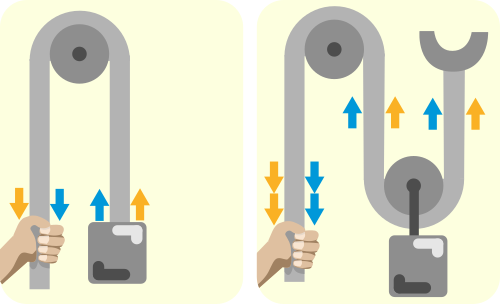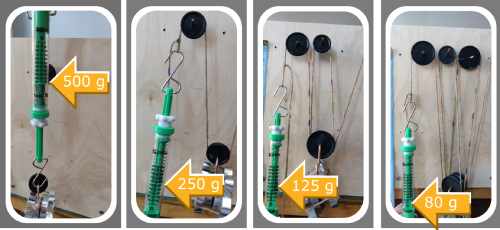How to build a pulley at home
Building the Pulley
A pulley is just a rope slung over a wheel that is used to lift something. The simplest way to do this is to tie the rope to the weight and then feed the rope over a pole or onto a wheel and then pull down on the rope. Since you're pulling down on the rope instead of trying to heave the weight upwards it might be slightly easier to lift than before, but the pulley isn't really doing much for you at this point. It is possible to get the pulley to really help you out though - we call this a mechanical advantage and it's all to do with how the rope goes between your weight, through the wheels and down to your hands. Find out more with the videos below.
How does the Pulley Work?
Pulleys can be built with construction sets you might have or used to play with - now is a good time to dig it out of the loft and have a go! Watch this video to see one in action.
A pulley works by sharing the force you are pulling down with across multiple ropes. This increases the amount of force you can apply easily but, unfortunately, the cost of that is the distance you have to pull the rope. The more mechanical advantage, the easier it is to lift, but you'll end up having to keep on pulling and pulling and pulling to raise the weight!
The amount of energy required to lift the weight a certain distance stays the same - we call this work. There is an equation you might learn in GCSE Science:
work done = force applied × distance moved

Blue arrow - distance moved, orange arrow - force applied
Mechanical Advantage
To show how different mechanical advantages can be set up and the difference it can make to lifting something, watch the video below.
We have seen a mechanical advantage of 2, 4 and 6 - all even numbers.

What do you think we would need to do to get an odd mechanical advantage? There's one thing in common between all of these pulley set ups - you can see the rope starts off tied to the board behind the weight. If it started off tied to the weight instead.... try it out at home if you've got the wheels to set one up!
Phil has been tinkering with a set of K'Nex to build a pulley. Things started off simple with a 2x mechanical advantage system but - Engineers out there - what is the mechanical advantage of this one?

